
There are certain design and planting features that will greatly reduce summer heat in a garden, and they go way beyond just providing shade. By tapping into the power of the air, water, stones, shade, and cooling plants, you can create a pleasing outdoor garden space that will help temper the high heat of summer.
Here are some of the best tools in the design toolbox for creating cool (and cooling) garden spaces.
Increased Airflow
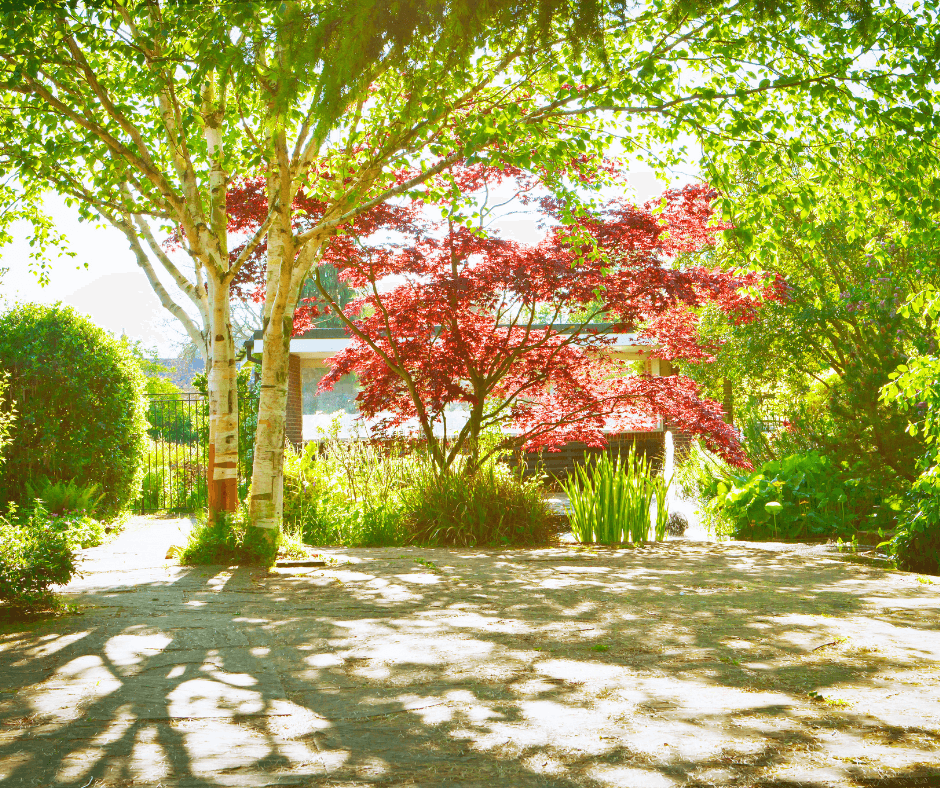
Keeping areas of your garden open, to facilitate airflow and catch prevailing winds, will not only cool your garden but dissuade flying insect pests, like mosquitoes. Allowing for some open spaces around your garden for welcome breezes is also pleasing to the senses. You can even plant a few fragrant plants, such as gardenias (Gardenia jasminoides), pots of sweet alyssum (Lobularia maritima), jasmine tobacco (Nicotiana alata), and fragrant roses, upwind for the additional pleasure of natural aroma.
Cooling Walls
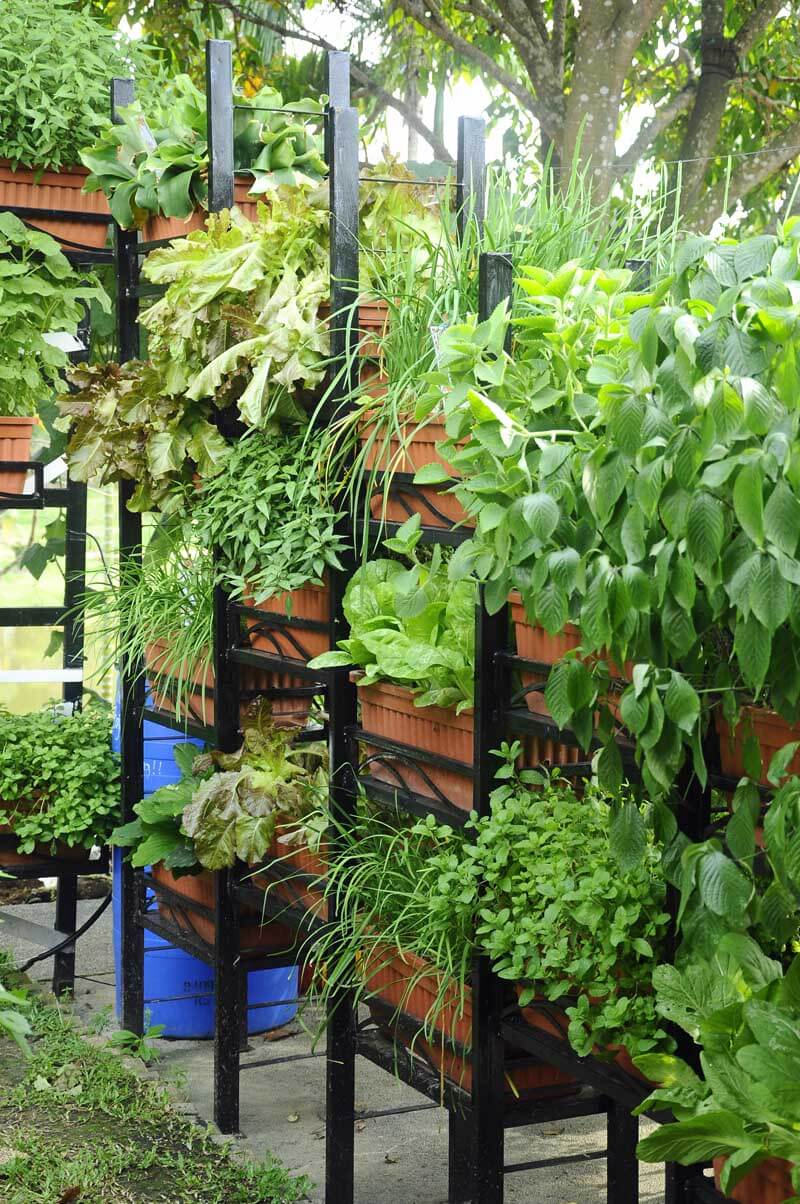
If an enclosed garden is what you have (or want) then green walls and/or shaded stone walls don’t radiate heat. Trellised or clambering vines, like climbing roses, golden-flowered Carolina jessamine (Gelsemium sempervirens), scarlet honeysuckle (Lonicera sempervirens), or espaliered fruit trees, cool sun-drenched fences, or hardscaped walls because they don’t absorb and release heat. They also look lovely. (Click here to read more about great garden honeysuckles.)
Plantable green planter or pocket walls will also do the trick, and these can be filled with herbs and edibles for culinary gardeners. Water-permeable, felted wall pockets on a freestanding support make this very easy. Florafelt living wall systems are easy-care, quality options that help homeowners install plantable walls in no time. Tall, outdoor planter shelves or freestanding trellis walls are two other options. Both also facilitate airflow.
Shaded stone walls or patio stones are also greatly cooling because they hold the lower temperature of the night and emanate it during the day, which effectively reduces the temperature of any shaded patio.
Green Canopies
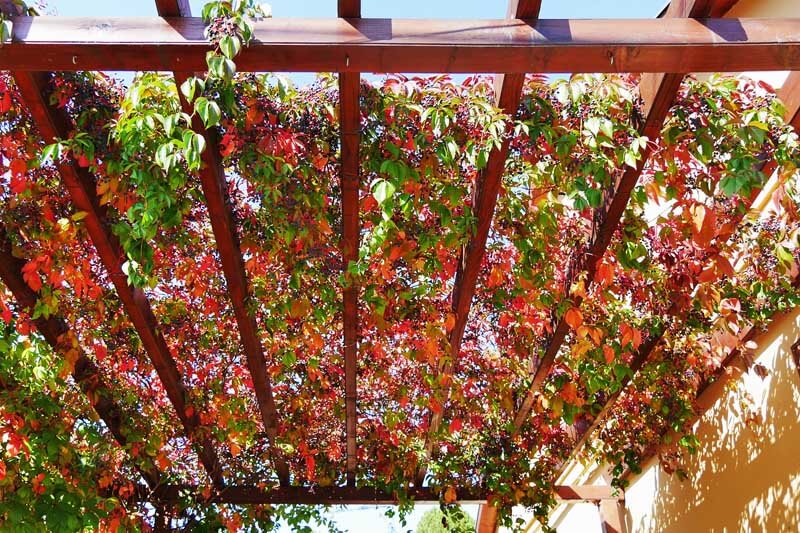
Pergolas, arbors, or arbored tunnels covered with vines will stave off the summer heat because they don’t absorb heat, and they release cooling moisture into the air. Grapes (Vitis spp.) are one of the best vines for the job. Not only do they produce fruit, but they are long vining, tolerant of a wide array of weather conditions, and have very large leaves that provide good cover. Other good long-vined candidates include brewer’s hops (Humulus lupulus), if you make your own homebrew, as well as native Boston ivy (Parthenocissus tricuspidata) and Virginia creeper (Parthenocissus quinquefolia), which both turn brilliant hot colors in fall.
Large-Leaved Tropical Plants
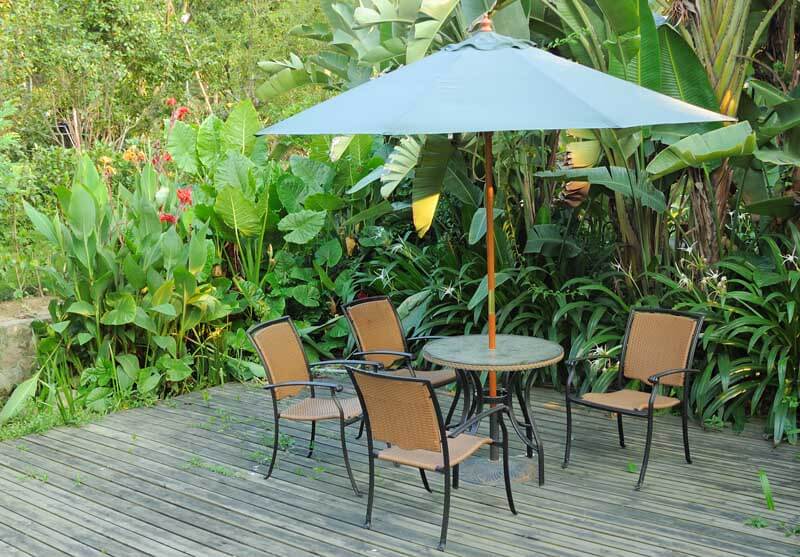
Whether grown in pots or the garden, invite a few very large-leaved tropical plants into your outdoor space. The best are rainforest plants that take up and release moisture in high amounts, which makes them perfect for hot patios or deck sides. Tender varieties for large pots or garden spaces are elephant ears (Colocasia esculenta), giant elephant ear (Alocasia spp.), and false banana (Ensete ventricosum ‘Maurelii’). The hardy to semi-hardy Sichuan hardy banana (Musa basjoo, USDA Hardiness Zones 7-10), which can reach 20 feet, is an in-ground option that will live from year to year in southern zones. For potted specimens, choose a potting soil that holds extra water, such as Black Gold® Moisture Supreme Container Mix and Black Gold® Waterhold Cocoblend Potting Mix.
UV Blocking Patio Umbrellas
Obvious cooling features in the garden are umbrellas and canopies that provide cooling shade, but they are even more effective if they block UV rays. Those designed for UV protection are more reflective. Light-colored canopies also absorb less heat, which increases their cooling ability.
Airy Green Borders
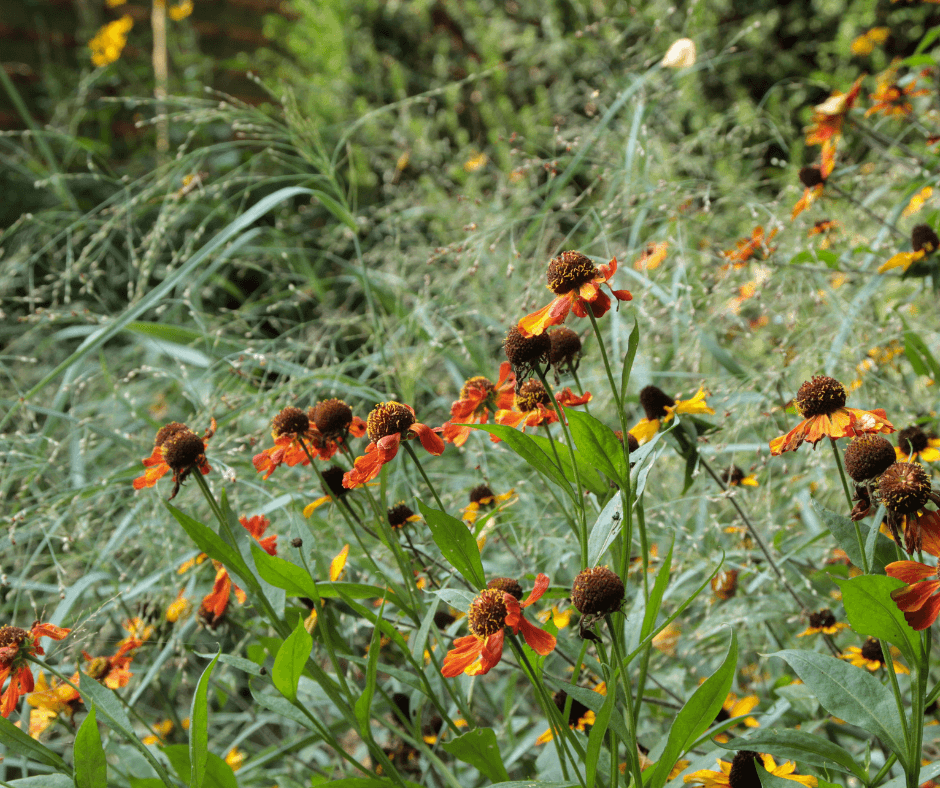
Some shrubs and tall, airy plants are less dense, allowing them to facilitate more airflow, while also providing pleasing garden borders. Low, airy shrubs, like the 4-foot Longwood Blue bluebeard (Caryopteris cladonensis ‘Longwood Blue’ (expect it to self-sow)) and Grand Cascade butterfly bush (Buddleia davidii ‘Grand Cascade’), with its 6-foot habit and large purple flowers that lure butterflies, are ideal.
Tall grassy garden borders are also pleasingly airy and attractive. Three excellent options include the plumy, 6-foot Cloud Nine switchgrass (Panicum virgatum ‘Cloud Nine) with its blue-green foliage, or the 5-foot ‘Northwind’ with its large seedheads and olive-green blades. The impressive 6-foot Windwalker® Big Bluestem is another beauty with linear clumps of blue-grey foliage, maroon floral plumes, and maroon fall foliage. It’s a real showstopper that flows in the breeze.
Effective Tree Cover
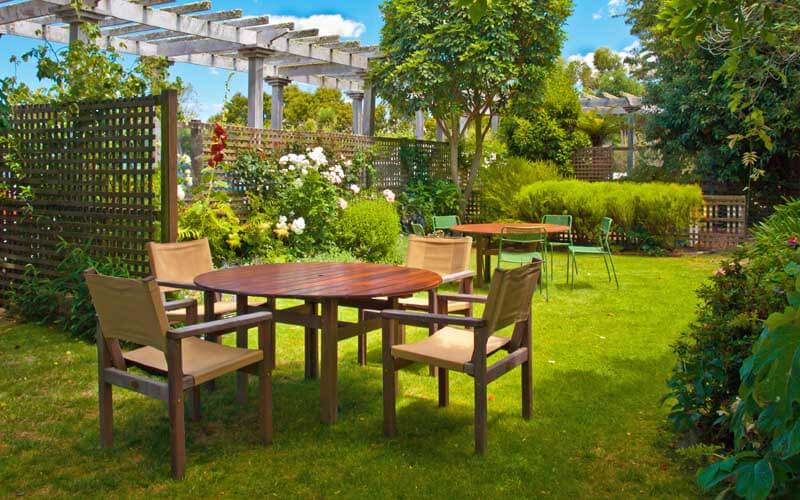
High tree canopies make for breezier shaded spaces, but trees offer far more than just shade. They are also natural air conditioners because trees draw up water from the soil and release it from their leaves as fine mist. This process is called transpiration. Broad-leaved, deciduous trees with larger leaves transpire more for more cooling power. During a growing season, a leaf will transpire many times more water than its own weight. In fact, a large oak tree can transpire up to 40,000 gallons (151,000 liters) of water per year!
Water Features
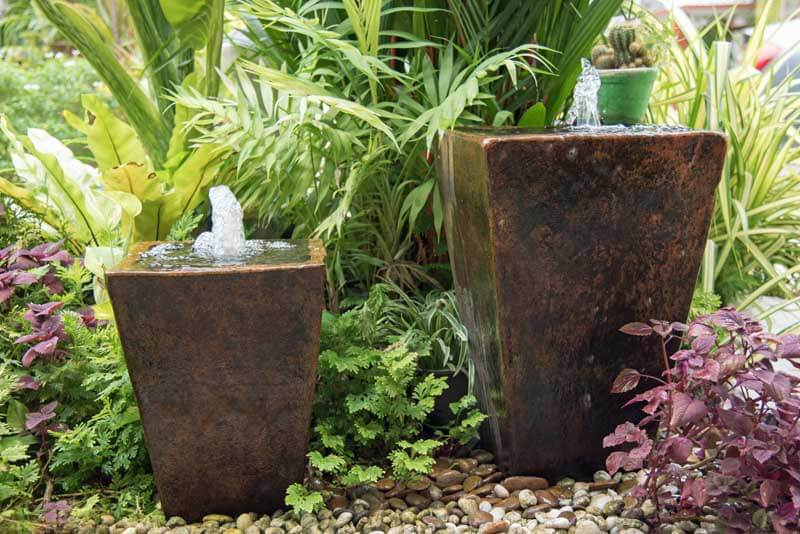
Moving water in the garden is pleasing to the senses and really cools garden spaces. Whether you install a small fountain, a bubbling pool, or a small fish pond, these serene features will improve your outdoor living space. One key consideration is to only install features with moving water or fish to avoid creating mosquito breeding ground.
Mosquito Control
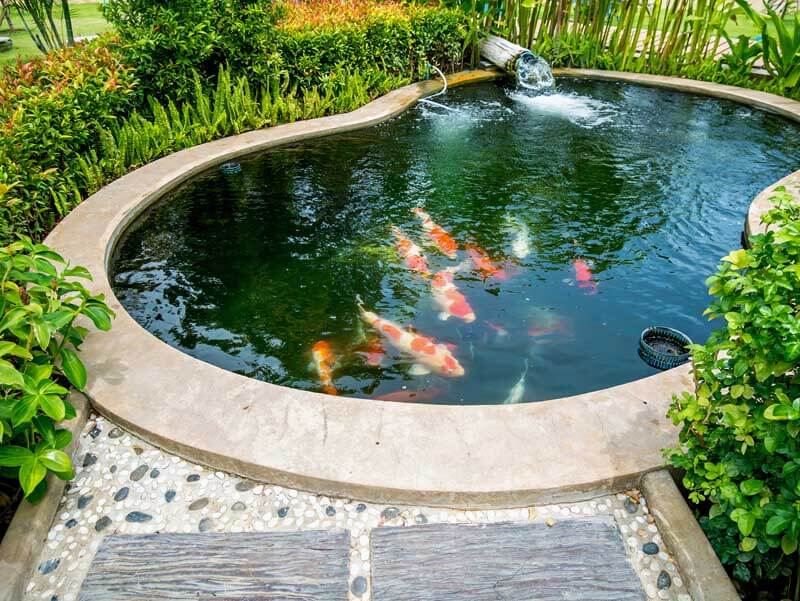
Some of the cooling options mentioned can invite mosquitoes due to increased moisture and shade cover. Here are some solutions that can really help.
If you add a water feature to your garden, remember that still or stagnant water creates the perfect mosquito breeding ground. Moving water does not. Fish ponds, however, are acceptable because fish consume mosquito larvae. You also need to beware of birdbaths–refreshing their water every few days will wash away any developing mosquitoes.
Full sun is not favored by mosquitoes, but shaded gardens invite them. Several non-chemical means of keeping mosquitoes away include the use of citronella candles and burning tikis. Newer options include electronic mosquito repellers, which create a 15-foot deet-free cloud of repellent across an area. Several plants also help to repel mosquitoes. Those for more shaded locations include lemon balm (Melissa officinalis), which emits a lemony scent and will grow in partial shade. The equally citrusy lemon verbena (Aloysia citriodora) will tolerate light shade. (Click here to discover more mosquito repelling plants.)
A mix of these garden design features will help naturally cool your favorite garden enclaves and outdoor spaces, even on the hottest days.

